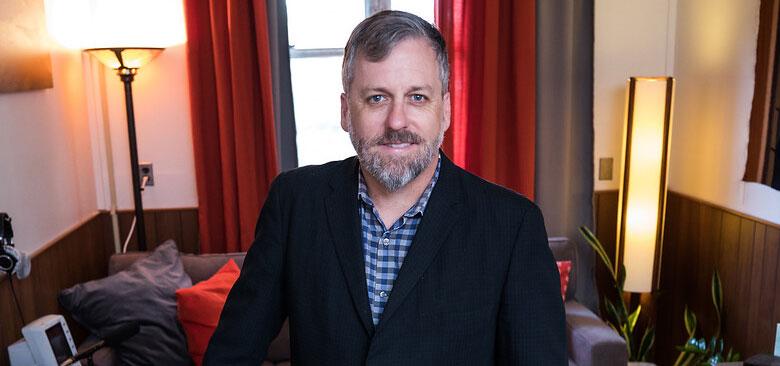
UCSF School of Nursing Associate Professor Andrew Penn will be examining the effects of MDMA, a psychedelic drug, on those battling post-traumatic stress disorder in a "breakthrough" study. (Photo by Elisabeth Fall)
A New Look at an Old Model: Psychedelic Drugs and Patient Care
Investigating the therapeutic benefits of psychedelic substances seemed far-fetched 35 years ago. For researchers daring enough to try, the attempt could derail their careers.
Research in psychedelic substances – once outlawed from academic inquiry – has been revived. UCSF School of Nursing associate professor Andrew Penn is exploring the effectiveness of these psychedelics in a “breakthrough” study.
A Psychedelic Renaissance
Research on psychedelic drugs was commonplace in the 1950s and 1960s, but dramatically changed when those drugs seeped into America’s youth culture. In response, Congress passed The Controlled Substances Act in 1970. The legislation categorized substances, including psychedelic drugs, into five schedules with Schedule 1 drugs the most difficult to study. Schedule 1 substances, according to the law, have a high potential for abuse, were deemed to have no medical benefit, and were not safe to use – even under medical supervision. When a researcher petitioned to study a Schedule 1 drug, the government often refused.
“It would be career suicide,” Penn said. “The Controlled Substances Act made it so a lot of people in academia moved away from studying this.”
Then in the early 2000s, researchers from Johns Hopkins University received governmental approval to experiment with psychedelics. Their 2006 paper detailing the safe, positive and lasting effects of psilocybin, a psychedelic compound found in certain mushrooms, triggered a research resurgence.
MDMA and PTSD
One banned substance is methylenedioxymethamphetamine (MDMA), a synthetic drug that produces “feelings of increased energy, pleasure, emotional warmth, and distorted sensory and time perception,” according to the NIH’s National Institute on Drug Abuse. MDMA is often referred to as ecstasy, but Penn says that “what is sold as ecstasy on the street can be any number of chemicals that may or may not be MDMA.”
Penn is part of a team that will examine the effects of MDMA on people suffering from post-traumatic stress disorder (PTSD) in a study the FDA has termed a “Breakthrough Therapy.” The designation allows the study, sponsored by the Multidisciplinary Association for Psychedelic Studies, to be fast-tracked because of its promising early results.
UCSF’s Jennifer Mitchell, associate professor in neurology, and Joshua Woolley, associate professor of psychiatry, are also leading the study. Penn is serving as a therapist.
As part of the research leading up to this trial, six Phase 2 clinical trials were performed in four countries. Fifty-four percent of participants no longer met the criteria for PTSD after three sessions of MDMA-assisted therapy. More promising was that most patients experienced only mild side effects such as headache, transient anxiety, fatigue, jaw clenching and lack of appetite.
When administered in a controlled setting, MDMA can provide patients with a greater tolerance for detailing traumatic events, Penn said. Imaging shows MDMA “quiets” the parts of the brain associated with fear or threats. MDMA also triggers the release of serotonin, which is associated with attention and memory, and prolactin and oxytocin, hormones associated with bonding.
Some patients with PTSD get so overwhelmed or flooded by the distressing memories that they are unable to engage in therapy, Penn explained. Others essentially shut down because the memories are too painful. He said MDMA allows patients to stay in a “sweet spot” that allows participants to engage enough where they can talk about trauma without being overwhelmed. MDMA also enhances the trust between therapist and patient.
“People with PTSD often have an impaired capacity for trust because a lot of times, their trauma is interpersonal – somebody who was supposed to take care of them, hurt them,” Penn said. “Understandably, they’ve developed a certain wariness of other people and struggle with trust. But in order for therapy to be successful, you have to be fairly trusting of your therapist.”
Penn emphasized the importance of combining psychotherapy with medication. Penn said the combination of medication and therapy is not uncommon, but often siloed. What differentiates this structure is that the therapy and drug administration is conducted concurrently for a limited time whereas, in most instances, medication is taken continually over longer stretches.
“I’ve treated plenty of patients over the years who have somebody over here prescribing medications and somebody over there doing therapy and those people never talk to each other,” he said.
Psychedelic drugs and nursing may seem to be odd partners, but Penn said it’s not strange at all. In palliative care, if a patient had excruciating pain from bone cancer, nurses would help minimize the pain. That principle applies to mental suffering as well.
“This therapy maps very well to the core ethos of nursing,” he said. “A lot of nursing is about impacting the lived experience of illness. Psychedelics map nicely because it’s changing the relationship with disease. Maybe we can’t cure a mental illness, but we can drastically change the relationship somebody has with it.”
An Open Dialogue on Cannabis
In addition to his work on PTSD, Penn recently authored two articles related to cannabis in the Journal of Psychosocial Nursing and Mental Health Services. While the articles detail the science of cannabis use and the body’s response, they also provide guidance for nurses treating patients who use it.
The current climate for health care professionals is challenging because the patient is often more informed than the clinician about cannabis.
That has led patients to use cannabis to deal with symptoms and illnesses – some as serious as PTSD and schizophrenia – without consulting health care professionals. Penn’s papers advocate for an open dialogue between clinician and patient, allowing health care professionals to caution patients when they may be using cannabis in a way that imperils their health, but also permit the patient’s experiences with cannabis to play a role in their own health care.
“It’s critical we have a sophisticated conversation because our patients are increasingly having a sophisticated understanding of [cannabis],” Penn said. “There’s an understandable wariness of cannabis users to talk about their cannabis use because they’re concerned they’re going to be misunderstood or it be seen as a problem when they don’t have one.”
Complicating the matter further is a lack of research on the benefits of cannabis, which is still listed as a Schedule 1 drug. There’s a plethora of research on the harms of cannabis – and Penn emphasizes there are plenty – but little on its value.
Quoting Carl Sagan, Penn said: “The absence of evidence is not evidence of absence.”



